Appendix 1: Foundation Project summaries and progress 2013
under construction

1. THE TARDIS PROJECT: TRACKING ANCIENT RESIDUES DISTRIBUTED IN THE SILICATE EARTH
Themes 2 and 3, Earth Evolution and Earth Today, contributing to understanding Earth’s Architecture and Fluid Fluxes.
AIMS:
The most robust record of the Os isotope composition of the Earth’s convecting mantle is provided by Platinum Group Minerals in ophiolites and komatiites. From these, fundamental information on the origin of the Earth and the evolution of its core-mantle system can be obtained. In this project, an international team of leading mantle researchers uses a unique combination of techniques to provide new insights into deep mantle processes with the following specific objectives: (a) to define the initial composition and evolution of Earth’s convecting mantle using the Re-Os isotopic systematics of platinum-group minerals and sulfides from ophiolites and komatiites; (b) to understand the origins of ophiolitic chromitites; (c) to understand the relation of Os-isotope heterogeneity in the convective mantle to major events in Earth’s evolution; (d) to evaluate the evidence for the preservation of large volumes of ancient continental mantle within the ocean basins.
.jpg)
Qing Xiong, Tibet.
PROGRESS IN 2013:
During 2013 we continued our work on a large collection of chromitites from ophiolite localities worldwide; this collection continues to grow, especially through our active collaboration with groups at the Universities of Barcelona and Granada. The chromites (and associated silicates) were analysed for major- and trace-elements, and were surveyed petrographically to locate and identify any platinum-group minerals (PGM) or base-metal sulfides (BMS) residing in them. Those that were found were then analysed by LA-MC-ICPMS to determine their Os-isotope compositions. Approximately 300 Os-isotope analyses of PGM have been carried out; a larger number (>1000) of BMS analyses was carried out, with ca 20% containing enough Os to give reliable results. Dr González Jiménez finalised his PGM-based projects before leaving to take up a senior teaching and research post at the University of Santiago; he will continue to collaborate with the project, expanding our network in this field with colleagues in Chile.
Field work in Tibet (collaboration with Dr Rendeng Shi, CAS, and Professor Jingsui Yang, CAGS) added more sample sets. This collaboration has turned much of the activity in the project toward trying to understand the highly reduced UHP assemblage enclosed in the chromitites and peridotites of the “ophiolites” along the Yarlung-Zangbo Suture Zone in Tibet. A major achievement during the year was the discovery of minerals derived from the Transition Zone, implying that some of the Tibetan “ophiolites” have been subducted to depths of at least 500 km, and then been rapidly exhumed to be emplaced in the crust, bringing in the geodynamic modelling strand with Dr Juan Carlos Afonso. Application of new methodologies for mineral separation using the selFrag, as described in Technology Development Project 3, were critical for this.
U-Pb dating of zircons from the chromitites (by Dr Elena Belousova), and Re-Os dating of laurites in similar samples, suggest that the peridotites in the suture had resided in the Transition Zone for several hundred million years before their exhumation. EBSD studies of the chromitites by Takako Satsukawa are yielding spectacular and unexpected information on deformation and recrystallisation in the Transition Zone.

Nicole McGowan examining the Antalya ophiolite, Turkey.
To provide comparative material for the ophiolite work, we have continued studies of PGM and BMS in xenoliths from the subcontinental mantle. Dr Jin-Xiang Huang continued her work on metasomatism in mantle-derived eclogites, SIMS analysis of O isotopes in metasomatised rocks, and the development of standards for O-isotope analysis of Cr-rich garnets. She began a large project on Mg and Fe isotopes and their behaviour in mantle metasomatic processes, involving work in CAS Beijing laboratories with 2-way technology transfer.
Mr Qing Xiong, a cotutelle student with the China University of Geosciences, Wuhan, is working on ophiolites and ultramafic complexes in two parts of Tibet. During 2013 his work focused on the Zedang complex in the Yarlung-Zangbo Suture Zone. Mr Ed Saunders completed his PhD thesis on the mobility of gold in the mantle. Ms Nicole McGowan continued her multi-isotopic study of chromitites and their host rocks in direct collaboration with Dr Rendeng Shi (Institute for Tibetan Research, Chinese Academy of Sciences) who has provided her with key samples from three Tibetan ophiolites; her work also includes ophiolites in Spain and Turkey.
Published outputs:
CCFS 2013 Publications #198,199, 200, 215, 212, 234, 235, 236, 237, 239, 281, 320, 324, 334, 344, 348, 349, 352, 361, 362, 375
Conference Presentations:
21 International conference presentations including 4 Keynote

2A. METAL SOURCES AND TRANSPORT MECHANISMS IN THE DEEP LITHOSPHERE
Theme 3, Earth Today, contributing to understanding Earth’s Architecture and Fluid Fluxes.
AIMS:
This project is designed to (1) provide new knowledge of the character and behaviour of Earth fluids, such as silicate and sulfide melts, brines, vapours, hydrocarbons, supercritical fluids, at the P-T conditions of the lithospheric mantle and asthenosphere, and (2) unravel the complex transport and concentration mechanisms of siderophile-chalcophile elements such as Ni, Cu and PGE in the deep lithosphere.
PROGRESS IN 2013:
In 2013, considerable progress was achieved in two areas; firstly, the generation of new experiments, and secondly, new analyses from both the Ivrea Zone in Italy and the Thrym Complex in Greenland.
After overcoming numerous technical difficulties in the first year of the project in setting up the new methodology that would permit measurement of the compositions of hydrous fluids in equilibrium with mantle rocks, progress has been made on experiments with various water contents. Twenty new experiments have been performed on H2O-saturated basanite compositions that extend the range of investigated conditions from 0.5 to 4.0 GPa and 950 to 1200 °C. These augment experiments on both dry and H2O-undersaturated mixes for the purpose of determining the dry and H2O-saturated liquidii of the basanite, as well as the solubility of H2O in the basanite melt. In combination, these studies provide important information about the likely distribution and compositional characteristics of H2O-fluids in the Earth’s mantle and lower lithosphere. They also provide the basis for more advanced experimental studies on S-bearing aqueous fluids under mantle conditions that are planned for the coming year.
The key successful experiments have now been submitted for publication in an international peer-reviewed journal. These experiments reveal that although most incompatible elements and chalcophile metals are sparingly soluble in H2O-fluids at low pressures and temperatures (i.e. 950 °C at ≤ 1.0 GPa), they become increasingly soluble at higher temperatures and (more particularly) pressures. H2O-fluids and basanitic melts were found to be completely miscible by 4.0 GPa at 1100 °C. The new data also reveal that, relative to silicate melts, H2O-fluids preferentially incorporate alkalis, Ba and Pb. In contrast, rare earth elements have much lower solubilities. This is consistent with previous predictions for the role of H2O-fluids during arc processes and continental crust production. However, the experiments also reveal that high-field-strength elements (Nb, Ta, Zr, Hf, Ti) are relatively soluble in H2O-fluids (contrary to previous expectations) and thus residual rutile is a necessity if H2O-fluids are to be a key element of arc magma and continental crust development.
Since this project began in August 2011, 3 Honours and 1 Masters students have been supervised and trained to work in challenging, remote and complex environments. Three field seasons have now been completed both in the Ivrea-Verbano Zone (IVZ) and in the Thrym Complex. Research concentrated initially on the genesis of several nickel-copper sulfide deposits that occur in enigmatic mafic/ultramafic, alkaline and volatile-rich pipes that intruded into rocks of the deep lithosphere in the IVZ. In order to identify the source and composition of the parental magma and the fluid that was evidently involved in the formation of the pipes and metal sulfide deposits, analyses comprised (1) whole rock studies (XRF, NiS fire assay, solution ICP-MS), (2) in-situ major, minor and trace element analysis of silicates, oxides, and sulfides (electron microprobe, laser ablation ICP-MS), and (3) analysis of water of pyroxene (SHRIMP-SI).
In 2013 we organised a very successful field trip in the Ivrea Zone between the Biennial Meeting of the Society for Geology Applied to Mineral Deposits in Uppsala, Sweden, and the Goldschmidt Conference in Florence, Italy, where the outcomes of this project were presented. This allowed a group of ten experts in nickel-copper sulfide systems from the University of Western Australia, Macquarie University, CSIRO and Minerals Targeting International to attend the field trip and to discuss topics related to metal transport and concentration in the deep lithosphere and upper mantle (Fig. 1).
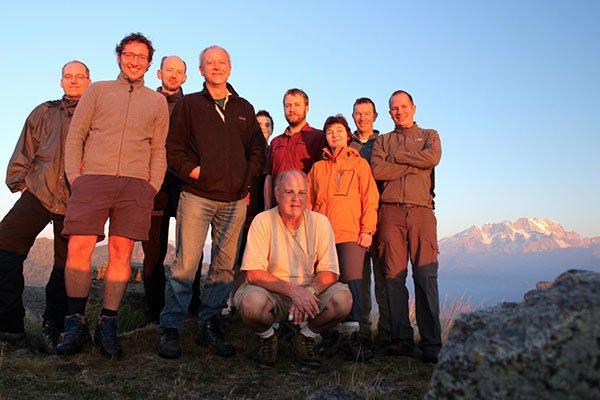
Figure 1. Participants of the 2013 CET-CCFS Field trip in the Ivrea Zone (Italy). From left to right: Marek Locmelis, Marco Fiorentini, John Adam, Steve Barnes, John Owen, Bob Loucks, Steve Denyszyn, Elena Belousova, Graham Begg, Nicolas Thébaud. In the background, the glaciers of the Monte Rosa.
In terms of analytical work, in 2013 we carried out detailed isotopic studies on samples from both the Ivrea Zone and the Thrym Complex with the aims of (1) identifying the source region of the sulfur that formed the sulfide deposits (i.e. crustal vs. mantle sulfur), and (2) better constraining the timing of events in the mineralised areas. While the work in Greenland is still under way and is planned for completion in 2014, work in the Ivrea Zone has already showed interesting results. Sulfur isotope studies conducted using the SIMS at UWA indicate that sulfides from the pipes yielded δ34S values of 0 ± 2 which is indicative of a mantle source. The geochronological studies included (1) U-Pb dating of zircon and apatite using laser ablation ICP-MS at UWA and Macquarie, respectively, and (2) 40Ar-39Ar dating of phlogopite using a noble gas mass spectrometer with laser probe and resistance furnace at Curtin University. Zircons separated from the pipe rocks suggest a crystallisation age of the pipes of 277 ± 6 Ma, which is slightly, but significantly, younger than the previously reported age of 287 ± 3 Ma. The younger age is in better agreement with field relationships and confirms a genetic link between emplacement of the pipes and widespread mantle metasomatism in the lithospheric mantle in this area during the late Carboniferous. The apatite yielded an age of 235 ± 20 Ma, whereas the phlogopite gave an age of 188.9 ± 1.3 Ma. These young ages likely reflect lower closing temperatures of apatite and phlogopite and/or regional cooling. However, there is some structural evidence that the phlogopite ages reflect a reopening of the system due to a small thermal spike that has not affected higher closure temperature phases, suggesting that part of the exhumation history of the Ivrea Zone is associated with extension at the continental margin rather than being completely Alpine. This question will be addressed in a new foundation project.
Published outputs:
CCFS 2013 Publications #32, 162, 174, 222, 228, 272, 310, 333, 389, 413, 419, 447, 448
Conference Presentations:
11 International conference presentations
See Research Highlight “Metals flow in mantle streams”

2B. DYNAMICS OF EARTH’S MANTLE: ASSESSING THE RELATIVES ROLES OF DEFORMATION AND MAGMATISM
Theme 3, Earth Evolution, contributing to understanding Earth’s Architecture.
AIMS:
Understanding the evolution of continental and oceanic mantle in extensional environments is key to understanding plate tectonics. How and why divergence initiates in extensional zones, and how continental rifts evolve to oceanic accretion centres are poorly constrained processes, but fundamental to decipher the processes structuring the lithosphere. This project explores the upper mantle from rifting to ocean-continent transition environments. We have studied several localities that provide a progressive history from rift initiation to subduction including the East-African Rift (Marsabit, Kenya), Sardinia and Platta-Totalp-Tasna massifs (Alps) to find how the deformation was initiated, localised and evolved in these geological settings. We also study the structural and geochemical relationships amongst fluids and/or melts during mantle deformation.
We have characterised the microstructure and the deformation mechanisms recorded by mantle minerals, such as olivine and pyroxenes, with the EBSD technique and combine microstructural observations with geochemistry to refine our understanding of the mantle processes.
PROGRESS IN 2013:
The study of the East-African rift (Marsabit-Kenya) is now finalised with the publication of a paper in Tectonophysics. We confirmed the activation of the E-type slip-system in a rifting environment and provide the first evidence of [001] slip in such an environment. Decompression and cooling from high-pressure and high-temperature could be the major factor influencing the localisation of deformation and the change in the dominant slip direction in olivine.
During 2013, we focused our work on Platta-Totalp-Tasna (Alps) peridotites sampled in 2012. These massifs represent a type example of a zone of exhumed continental mantle, and offer a complete sequence across an ocean-continent transition. We analysed major elements of primary minerals using the electron microprobe in 12 samples in Platta and Totalp massifs at the University of Lausanne, Switzerland. This was not possible in Tasna samples, which are highly retrogressed. We have undertaken the first EBSD analyses on these rocks. Moreover, the sample collection has been upgraded with a new field session by Mary-Alix Kaczmarek at the end of September 2013.
Clinopyroxene compositions from Totalp and Platta are distinct with a higher Na2O (wt%) content in Totalp than in Platta suggesting melt percolation and crystallisation of plagioclase in Platta peridotite. Within the Platta sequence, there is a slight variation of the Na2O content between two localities permitting a relative positioning within the ocean continent transition section. We focused our study on the highly deformed peridotites to characterise the mechanism activated during the deformation and to understand the influence of fluid/melt during deformation. The presence of high temperature amphibole (pargasite and kaersutite) in Totalp testifies to the relevance of the fluid percolation model. The peridotite and the ultramylonite contain porphyroclastic amphiboles (rounded in the ultramylonite), as well as the fine-grained matrix with an evolution of its chemical composition. The amphibole started to crystallise before the initiation of the deformation (large porphyroclasts) and continued to grow during the localisation of the deformation within the ultramylonite and the chemical evolution of the fluid/melt, which became focused in the mylonite. Our first EBSD results show an evolution of the deformation mechanisms from the host peridotite to the fine-grained matrix in the ultramylonite in Totalp with a possible slip change within the olivine from [100] to [001] slip, which might be related to the presence of fluid during deformation. For details and figures on our Alps research see Research Highlight "Straining to transform from continent to ocean").
Published output:
CCFS 2013 Publication #335
Conference Presentation:
M-A Kaczmarek and S. Reddy. Fluid percolation within an Ocean-Continent Transition, AGU 2013

3. GENERATING AND STABILISING THE EARLIEST CONTINENTAL LITHOSPHERE - LARGE GRANITE BLOOMS
Theme 2, Earth Evolution, contributing to understanding Earth’s Architecture and Fluid Fluxes.
AIMS:
This project aims to understand the genesis of the earliest continental lithosphere, including the processes of fluid/melt extraction that stabilise, and thus preserve, Archean cratonic lithosphere. It involves isotopic studies of zircons from ancient terrains and deep-crustal xenoliths worldwide, and a continued search for the oldest mantle samples beneath cratonic areas. Targeted field studies will provide a basis for static and dynamic modelling of the rheology of the crust before, during and after melt extraction.
This project is closely linked with the research of Future Fellow Dr Elena Belousova, involving regional surveys (TerraneChron® approach) of zircons (U-Pb, Hf isotopes, O isotopes) from old continental areas, to pick up the signatures of the oldest crust. Two areas are being investigated to look at some of the processes of crustal stabilisation: [1] the 3.1 Ga Mpuluzi batholith (Swaziland/RSA), and [2] the southern part of the North China Craton, where a similar “granite bloom” at the end of the Archean appears to have been the defining event that stabilised the crust.
PROGRESS DURING 2013:
Dr Belousova carried out studies of the Archean crust of the Volgo-Uralia region of the East European Craton, using both surface samples and material from super-deep drill holes.
This has demonstrated the presence of crust older than expected, and detailed information on the structure of the crust. The charnockitic lower crust in southern Volgo-Uralia consists of Eo- to Paleoarchean crust re-worked in the Mesoarchean (ca. 3.1 Ga). Hf model crustal ages of up to 3.9 Ga found for this region and farther northeast suggest that this Eo- to Paleoarchean continental crust was widespread in Volgo-Uralia. A back-arc setting along an active continental margin may explain the high-T, “dry” and “ferroan” magmatism of the Volgo-Uralian charnockites. An alternative interpretation is that deep mantle-plume activity at 3.1 Ga caused mantle underplating, extension of the Paleoarchean crust and high-T magmatism.
The ultramafic–mafic Noril’sk-1 intrusion in Polar Siberia (Russia) was another focus of Dr Belousova’s research. Despite the long-term study of the Noril’sk-type intrusions their origin remains controversial. Hf-isotope data on zircons, which serve as an explicit constraint on source regions, have been rarely applied to Noril’sk-type intrusions. We have explored the isotope systematics of hafnium in zircon and baddeleyite from variously mineralised rocks of the economic Noril’sk-1 intrusion. In situ Hf-isotope data for zircon and baddeleyite, combined with whole-rock Nd-isotope results, identify three distinct clusters of Hf-Nd isotope values typical of different lithological units (e.g. unmineralised gabbroic rocks, mineralised portions represented by ultramafic and taxitic-textured rocks with disseminated PGE-Cu-Ni sulfide and low sulfide ores, and gabbro-diorite). Our findings are consistent with a model that involves interaction of three distinct magma sources during protracted evolution of the Noril’sk-1 intrusion. The outcomes of this study suggest that a prolonged period for concentration of the ore components in staging chambers during this interaction may be a key factor for formation of such economic deposits.
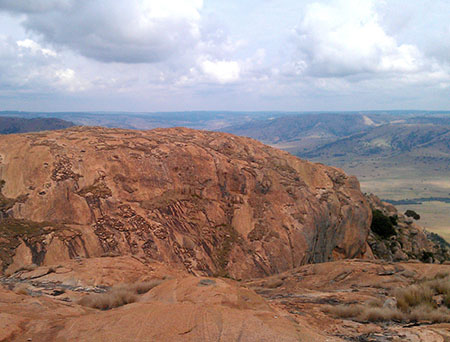
Large granite bloom, South Africa.
Work continued on identifying major tectonic events associated with crustal magma genesis to track patterns in crustal evolution for comparative benchmarks with the Archean tectonic regimes.
PhD student Yuya Gao (cotutelle with CAS, Beijing, a CCFS Partner) completed a study of Li isotopes in A-type granites and their zircons. She demonstrated that diffusion of Li in zircons during cooling from magmatic temperatures produces large isotopic fractionation. However, if large-enough grains (>100 microns across) are used, the Li-isotope compositions in their cores may be used to trace magmatic processes. Ms Gao has also produced a detailed evaluation of the processes of U-Pb-isotope disturbance related to the metamictisation of zircons, complete with a “recipe” for recognising zircons whose U-Pb systematics cannot be trusted. The A-type granites, on which she has concentrated, are typically the latest components in “granite blooms” and this work will be directly relevant, as an analogue, to the aims of the project.
Rosanna Murphy presented her work at international conferences in 2013; she has produced a detailed regional characterisation of the Barberton granite bloom at 3.15 Ga. The Sr-Nd-Hf isotopic data demonstrate the involvement of older crust (>3.5 Ga) in the genesis of the granites, which both constrains the tectonic setting (heat sources) and suggests that the high-degree melting of the lower crust at this time was the stabilising factor. Modelling of these processes has begun in collaboration with Dr Craig O’Neill.
Published outputs:
CCFS 2013 Publications #205, 213, 215, 214, 233, 311, 313, 319, 330, 344
Conference Presentations:
7 International conference presentations including 2 Keynotes.
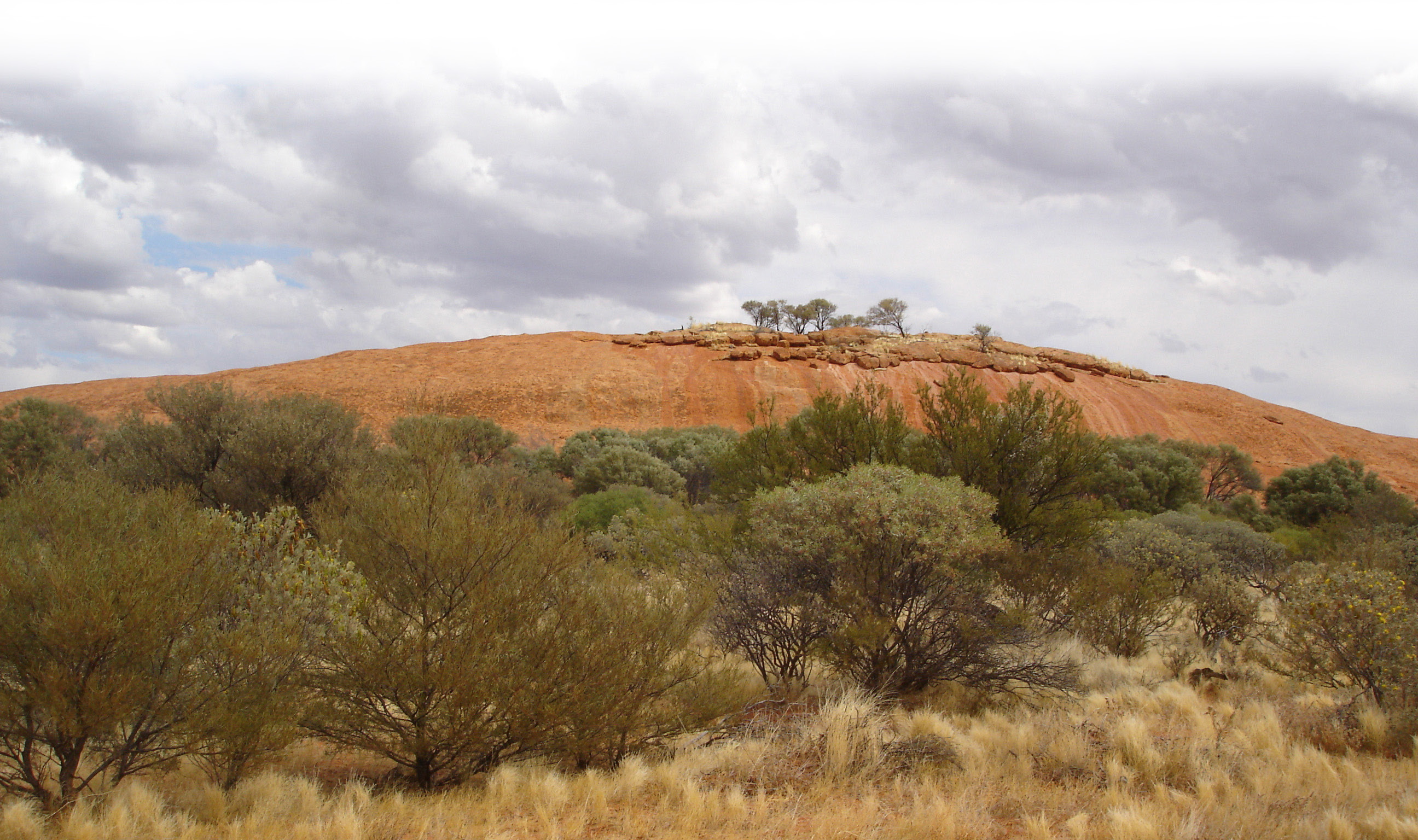
Large granite bloom, Western Australia.
4. TWO-PHASE FLOW WITHIN EARTH’S MANTLE: MODELLING, IMAGING AND APPLICATION TO FLAT SUBDUCTION SETTINGS

Theme 3, Earth Today, contributing to understanding Earth’s Architecture and Fluid Fluxes.
AIMS:
The overarching goal of this project is the development and application of in-house state-of-the-art computational tools to simulate and image complex geochemical-geodynamic processes involving two-phase reactive flow in multi-component deformable media. These tools, in combination with advanced seismic imaging techniques, will be applied to the problem of fluid transport from shallow dipping to flat subduction settings, in both the western USA and South China in the past.
PROGRESS DURING 2013:
This project is a long-timescale undertaking designed to operate over the lifetime of the centre, and lay the substrate for substantial numerical improvement in code capabilities. It consists of a three-pronged approach to numerical modelling and imaging of the deep Earth [1] Long-term development of codes towards a more complete geodynamic and geochemical description of mantle processes, led by Juan Carlos Afonso; [2] shorter-term applications, particularly in early Earth and planetary processes, involving the further development of existing codes, led by Craig O’Neill; [3] development and application of advanced seismic imaging techniques, led by Yingjie Yang.
The development of new multi-component multi-phase reactive flow formulations has been progressing with the PhD research of Beñat Oliviera. Some low-lying problems in the advection of chemical boundaries and reaction fronts have been resolved, with publications pending. We plan to integrate this with a multi-scale FEM framework within the next year to model sub-grid scale flow, which will then be coupled with concurrent developments in Aspect.
A number of publications using the multicomponent flow capabilities of CitcomS code to model chemical heterogeneities within the mantle have been produced, applying these modelling techniques to deep Earth recycling in the Hadean (first 500 million years of Earth history), the tectonothermal evolution of small planetary bodies such as terrestrial planets, moons and exoplanets, and the internal dynamics of Venus.
We have developed a new global convection capability using the new Aspect framework (dealii.org), and have extended it to include our own plate motion models, compositionally distinct particle formulation, and evolving boundary condition formulation. This work has been spearheaded by CCFS postdoctoral fellow Siqi Zhang. We have recently been successful in obtaining extra computation time at the larger resources at Intersect (the NSW high performance computing consortium), and the National Computing Facility.
Two new seismic imaging methods called Ambient noise tomography (ANT) and Multiple Plane Wave Tomography (MPWT) are being used to construct 3D seismic models on the basis of seismic data from the extensive broadband Transportable Array component of EarthScope/USArray, which are archived in IRIS/DMC and open for public download. The targeted areas are Western U.S.A and south China. We will augment these with seismic data from the Chinese Seismic Network, which will be obtained via collaboration with the Institute of Geodesy and Geophysics (an institute under Chinese Academy of Sciences). The combination of these two methods provides higher resolution information than traditional methods of surface wave tomography, with ANT producing information about the crust and uppermost mantle and MPWT generating information about the mantle. The cutting-edge nature of these studies was recognised with the award of a Future Fellowship to Yingjie Yang in 2013.
Meetings have been held in late 2013 to plan the integration of the new experimental mineralogy expertise in the CCFS into the optimisation of input into the geodynamic models; this will be developed further during 2014.
Published outputs:
CCFS 2013 Publications #196, 217, 218, 237, 315, 325, 330, 340, 414, 440, 441, 442, 883
Conference Presentations:
7 International conference presentations

5. EARLY EVOLUTION OF THE EARTH SYSTEM AND THE FIRST LIFE FROM MULTIPLE SULFUR ISOTOPES
Theme 1, Early Earth, contributing to understanding Earth’s Fluid Fluxes.
AIMS:
This projects seeks to define the nature of the first life in the early Archean, to discover links between the early evolution of life and the rise of atmospheric oxygen in the Neoarchean, and to understand the evolution of the Earth’s oceanic and atmospheric composition during the Archean and Paleoproterozoic. Links between the evolution of the sulfur cycle and the formation of important Archean submarine ore deposits will be evaluated.
PROGRESS DURING 2013:
Work has continued on the three main streams of the project during 2013: [1] David Wacey and Mark Barley focused on establishing the nature of the first life in the early Archean; [2] Marco Fiorentini and PhD student Carissa Isaac focused on evaluating the links between the evolution of the sulfur cycle and the formation of important Archean submarine ore deposits, principally komatiite systems; and [3] Martin Van Kranendonk concentrated on the adaptation of life to the rise of atmospheric oxygen and cooling of the atmosphere during the Paleoproterozoic Great Oxidation Event (GOE), in addition to continuing studies on the geological setting of the earliest convincing evidence of life the 3.5 Ga Dresser Formation of the Pilbara Craton. Ongoing work is also looking at documenting the sulfur isotope signature of a wide range of VMS systems in Western Australia.
The work on establishing the nature of the first life in the early Archean includes the discovery and documentation of ecosystems of bacteria in ~3.5 billion-year-old rocks from Western Australia, extending the geological range of such complex ecosystems to around 300 million years further back than known previously. In addition, we have found supporting evidence for a volcanic caldera setting for the earliest convincing evidence of life from a detailed study of hydrothermal alteration facies associated with the 3.5 Ga Dresser Formation. We also developed a new hypothesis that the volcanic rock pumice may have provided the ideal environment in which life could have evolved, and followed this up with a detailed study of some of Earth’s oldest pumice deposits from the ~3.5 billion year old Apex Basalt of Western Australia. Work in this project also identified consortia of 1,900 million-year-old fossils from rocks around Lake Superior, Canada, providing the first ever snapshot of organisms eating each other and outlining the types of microbial metabolisms were present on the ancient Earth.
Evaluation of the links between the evolution of the sulfur cycle and the formation of komatiite-hosted ore deposits have led researchers to identify sulfur dioxide degassing from komatiite volcanoes as a single process that explains two major heretofore unrelated conundrums about the Archean Earth System: (1) why are komatiite-hosted nickel deposits so well endowed? and; (2) why did the mass-independent record of S isotopes suddenly blossom 200 million years before the GOE? In terms of conceptual understanding, the demonstration that sulfur dioxide degassing can lead to economic Ni deposits is as exciting the proposal that earthquakes cause gold deposits. We have identified a volcanic pulse of sulfur dioxide that fundamentally restructured Earth’s S cycle. This provides a solid geologically based hypothesis for the bloom in S-MIF at 2.7 Ga that contrasts with model-based suggestions of changing CH4/O2 ratios at this time.
In 2013, Martin Van Kranendonk and colleagues undertook detailed mapping of the 2.4-2.3 Ga Turee Creek Group, deposited as a conformable succession throughout the period during which atmospheric oxygen rose. Major discoveries include [1] a second unit of glaciogenic diamictite, [2] an expanded transitional section across the GOE in which the change from anoxic to oxygenic conditions are preserved, [3] new units of stromatolitic carbonates from below and above the transition, and [4] a set of microfossil-iferous black chert units. All of these document the adaptation of life to changing atmospheric conditions (composition, temperature). A scientific drilling program was completed across three intervals of the group to obtain fresh drill core samples aimed at documenting the adaptation of life to this major revolution in Earth history.
The three key aims of the Foundation Project have been fulfilled. Research on the evolution of the Earth’s oceanic and atmospheric composition through the Precambrian has led to some important new insights. A study on S-isotopic variation across the rise in atmospheric oxygen from the Paleoproterozoic succession of Western Australia identified the largest yet recorded swing in δ34S isotopic compositions and the rise of seawater sulfate concentrations. The work on earliest life has shown that there are still new discoveries to be made on potential habitats where life signatures may be discovered.
The compilation of geotectonic and biogeological data across the Precambrian revealed long-wavelength cyclical changes in atmospheric composition tied to the supercontinent cycle, whereby periods of rapid crust formation immediately preceding supercontinent amalgamation events were followed by precipitation of banded iron-formations during the dénouement of the supercontinent cycle, and then followed, in turn, by periods of widespread (or even global) glaciation as the supercontinent cycle restarted. Earth’s supercontinent cycle evolved in a way previously undocumented, peaking at ca. 1.1 Ga and decreasing in intensity thereafter, paving the way for a new look at how life evolved and responded to changing conditions through time. With associated changes in the biosphere linked to these geological changes through a successive, causative series of events tied to mantle dynamics, this study will form the conceptual basis for the realignment of this Foundation Project.
Published outputs:
CCFS 2013 Publications #22, 232, 321, 329, 421
Conference Presentations:
4 International conference presentations

6. DETECTING EARTH’S RHYTHMS: AUSTRALIA’S PROTEROZOIC RECORD IN A GLOBAL CONTEXT
Theme 2, Earth Evolution, contributing to understanding Earth’s Architecture and Fluid Fluxes.
AIMS:
By investigating targeted Australian Proterozoic mafic igneous rocks, we aim to (1) push our knowledge of the Earth’s paleogeographic and geodynamic history back to the Paleoproterozoic, and (2) test a ground breaking hypothesis that the birth and death of a supercontinent on the Earth’s surface is intimately linked to the spatial and temporal location of superplumes, and that cyclic supercontinent-superplume events and associated fluid events dominate Earth’s evolution.
PROGRESS DURING 2013:
The project made major progress in three aspects during 2013.
In terms of revising late Precambrian global paleogeography and pushing our understanding of supercontinent evolution back to the Paleoproterozoic, we published two milestone papers. One was accomplished with colleagues from Yale and McGill universities (CCFS contribution #314), in which we presented a updated set of 825–540 Ma global paleogeography that illustrates not only the global continental distributions from the breakup of the supercontinent Rodinia to the assembly of Gondwanaland, but also the accompanying sedimentary facies patterns. We were able to use these data to examine the Snowball Earth and competing hypotheses as well as the geodynamic controls on global sea-level changes (see Research highlight "Different continent configurations around 800 – 500 million years ago give new clues about extreme climatic variation").
Also, we published a new comprehensive paleomagnetic examination of Nuna evolution in collaboration with the Nordic Paleomagnetic Working Group (CCFS contribution #309; featured in Research Highlight "How "super" was Nuna?"). Instead of the widely held ca. 1.8 Ga formation for the pre-Rodinia supercontinent Nuna/Columbia (for example, see CCFS contribution #197), the supercontinent could have been formed as late as between 1.65 and 1.58 Ga by amalgamation of West Nuna (Laurentia/Greenland, Baltica, Cathaysia, Rockall and possibly India), East Nuna (North, West and South Australia, Mawson Craton of Antarctica and North China) and the juxtaposed Siberia and Congo-São Francisco cratons. Nuna broke apart at ~ 1.45–1.38 Ga through the separation of Australia/East Antarctica from Laurentia/Cathaysia. In CCFS contribution #386, we reported high-quality results for the 2.41 Ga Widgiemooltha dyke swarm of the Yilgarn craton, and produced provocative Archean-Paleoproterozoic reconstructions.
We finalised the paleomagnetic and geochronological study of the 1.2 Ga Ravensthorpe dykes (WA), with a manuscript reporting the results now submitted for publication. We also completed the analysis of the ca. 1.46 Ga sills and two undated dykes in the Bangemall Basin through collaboration with Professor S. Zhang (China University of Geosciences, Beijing). One of the dykes yielded a stable and well-grouped remanence with a direction very close to that of the 1.07 Ga Bangemall Sills (Wingate et al., 2002), suggesting that this dyke is related to the Warakurna large igneous province (Wingate et al., 2004). However, ca. 1.46 Ga sills yielded a scattered and internally inconsistent secondary remanence only, so further paleomagnetic study on this target is not warranted. We sampled a new paleomagnetic collection from the Mesoproterozoic Morawa Lavas (WA) during the 2013 field season.
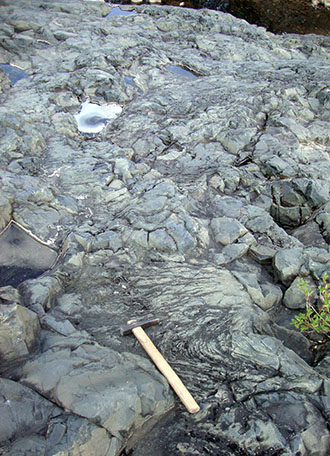
A field photo of pahoehoe structures in the 2 Ga Girvas volcanic edifice, Russian Karelia
We have continued our collaborations with Russian, Swedish and Canadian colleagues. A field trip to the 1.97 Ga Girvas intrusions, Karelia (Russia) in collaboration with the Russian Karelian Research Centre finalised our previous study; a manuscript is in preparation. New paleomagnetic data resulted in a new model for the Cryogenian-Ediacaran opening of the Paleo-Asian Ocean between Laurentia and Siberia (CCFS publication #302, in collaboration with the Institute of the Earth’s Crust in Irkutsk, Russia). New paleomagnetic and geochronological data from Sweden led to a revision of the history of the assembly of Rodinia (CCFS publication #345). New constraints on the reconstruction of the final breakup of Rodinia (the opening of the Iapetus Ocean) have been provided by precise 548 ± 1 Ma (U-Pb; baddeleyite) dating and a paleomagnetic study of the St Simeon mafic dykes in Quebec, carried out in collaboration with our Canadian and Swedish colleagues. In collaboration with Canadian, Portuguese and Brazilian colleagues, we proposed a new Mesoproterozoic reconstruction of Siberia and Congo/Sao Francisco constrained by LIPs barcode and paleomagnetic data (CCFS publication #221).
In terms of petrogenetic examination of possible plume events during the Proterozoic, we published our findings on the 1.2 Ga Ravensthorpe dykes (CCFS publication #371), collected mafic dyke and sill samples from the Bangemall Basin for analysis, and conducted petrographic examinations and major element analyses on these samples. Our work on the Ravensthorpe dykes led us to conclude that the dyke swarm was likely linked to a mantle plume (the Marnda Moorn LIP), and that the geochemical and emplacement characteristics of the dykes are attributed to relief in the lithosphere–asthenosphere boundary across the Yilgarn craton and complex interplay between the plume, a heated sub-continental lithospheric mantle, a normal asthenosphere, and recycled components. Our plume-lithosphere interaction model is consistent with the occurrence of synchronous ultrahigh-temperature events in the Musgrave Province of central Australia and the large volume of mafic magma in the Marnda Moorn LIP.
Published outputs:
CCFS 2013 Publications #32, 162, 186, 195, 219, 221, 223, 224, 250, 278, 293, 297, 299, 300, 302, 307, 314, 336, 353, 354, 386, 387, 422
7. FLUID REGIMES AND THE COMPOSITION OF THE EARLY EARTH

Theme 1, Early Earth, contributing to understanding Earth’s Architecture and Fluid Fluxes.
AIMS:
The first aim is to characterise the earliest crust on Earth, and identify additional localities where evidence for ancient crust may still be preserved. This is achieved by working on newly-discovered samples of ancient zircon, and acquiring a full geochemical and isotopic data set to compare with the huge inventory already obtained from Jack Hills and Mt Narryer in the Narryer Terrane of Western Australia. We aim to determine why so few Hadean rocks survived on Earth. The second subproject adds constraints from extra-terrestrial samples, including work on Martian meteorites and lunar samples in order to characterise any fluid present and their interaction with minerals. This involves a combination of geochemical and microstructural techniques, including SEM imaging, electron and ion microprobes, EBSD (Electron Backscatter Diffraction) and Raman spectroscopy.
PROGRESS DURING 2013:
Zircon grains extracted from both ortho- and paragneisses from the ultra-high temperature rocks of the Napier Complex, Enderby Land, Antarctica, were dated by SHRIMP and ion imaged by Cameca IMS 1280 using a single collector for Ti, Y, Hf, Pb, Th and U and a multi-collector for Pb isotopes. The patchy distribution of Pb that was previously identified in these samples was substantiated and found to be unrelated to zoning or crystal imperfections and has the ability to affect the 207Pb/206Pb age. This redistribution of Pb (and Ti) was further characterised by Raman spectroscopy and the Australian Synchrotron, and is attributed to the 2.5 Ga high-grade metamorphic event that affected the Napier Complex. Lu-Hf data from selected zircons were also obtained through collaboration with our Partner Organisation, the Institute of Geology and Geophysics at the Chinese Academy of Sciences in Beijing.
Work has commenced on samples obtained from the Australian Geological Survey from Aker Peaks in Kemp Land to the east of Enderby Land in Antarctica. Some of these yielded ages in excess of 3.5 Ga and also revealed ancient Hf model ages that extend back to 4.45 Ga, making this only the third locality on Earth where such ancient model ages have been consistently obtained.
Work completed last year on the re-investigation of >3.9 Ga zircon in the North Qinling Orogenic Belt in Central China was published in 2013 in Gondwana Research. This is the second locality after Jack Hills where Hf crustal model ages extend back to 4.4-4.5 Ga. The zircons occur in an Ordovician volcanic rock, establishing that ancient continental crust was present in the basement of the North China Craton during the Paleozoic. Additional samples from the Anshan district of the North China Craton were collected and will be studied in association with Yusheng Wan at the Chinese Academy of Geological Sciences.
Further work was completed on the Dharwar Craton of India, including the acquisition of Lu-Hf data at the Chinese Academy of Sciences. TTG components as old as 3.3 Ga are present in the eastern part of the craton, although the major events occurred in the Neoarchean, with two pulses of magmatism at ~2.55 and ~2.15 Ga. Work has also commenced on granitoids of the Bundlekhand Craton in India, with SHRIMP U-Pb age data and ICP-MS Lu-Hf data on zircon acquired during 2013.
The collection of data from a detailed traverse across the Jack Hills Belt was completed and the data are being prepared by Qian Wang as part of her doctoral studies at Curtin University. Both SHRIMP and MC-ICP-MS zircon data were collected for U-Pb and Lu-Hf study, respectively. In addition all suitable samples and investigated for rutile, monazite and xenotime in order to constrain the timing of metamorphism across the belt. Initial sampling of the Ilarra Greenstone Belt in the central Yilgarn Craton was undertaken and zircons extracted from a number of fuchsite quartzite horizons.
In extra-terrestrial work, we performed a detailed study of Zagami and Nakhla samples, combining EBSD and geochemistry. Nakhla is an olivine-bearing clinopyroxenite mildly shocked at 20 GPa. The analyses of major elements of minerals have been undertaken using an electron microprobe at the University of Lausanne (Switzerland). The clinopyroxenes are zoned from augitic to pigeonitic from core to rim and Mg# decreases from core (0.65) to rim (0.31). The Mg# of cpx rim is in equilibrium with the olivine Mg# (0.305-0.312) suggesting late crystallisation of the olivine. Zagami, which comprises clinopyroxene and maskelynite has been shocked at 27-31 GPa and 60-80 GPa (Stoffler et al. 1986; Lambert, 1995; Langenhorst et al. 1991) with the formation of melted shear-zones. Zagami clinopyroxenes display similar chemical zoning from core to rim as Nakhla, but is more irregular.
The analyses of preferred crystallographic orientation (CPO) of Nakhla clinopyroxenes show a weak fabric with the dominant activation of (100)[001] slip (Fig. 1). Olivine CPOs show a dispersed distribution, which is discordant to clinopyroxene CPOs where <001> cpx axes are not parallel to <100> olivine axes (Fig. 1). These observations, combined with the geochemistry, suggest that Nakhla clinopyroxenes crystallised under weak flow conditions and later the olivine crystallised in a more static, cumulate regime. Clinopyroxene CPOs of Zagami have a maximum concentration on <001> parallel to the observed foliation, inferring the dominant activation of the {110}[001] slip system. This is interpreted as the primitive deformation related to a weak flow. The intra-grain deformation in Zagami clinopyroxenes is complex with the dominant activation (100)[001] slip. Combining clinopyroxene geochemistry and microstructural data highlights two generations of twinning. The first generation of grain boundaries and twin planes acted as melt pathways illustrated by Fe enrichment. The second generation of twinning shows no chemical variation, suggesting a late activation. It is possible that Zagami records a double shock impact.
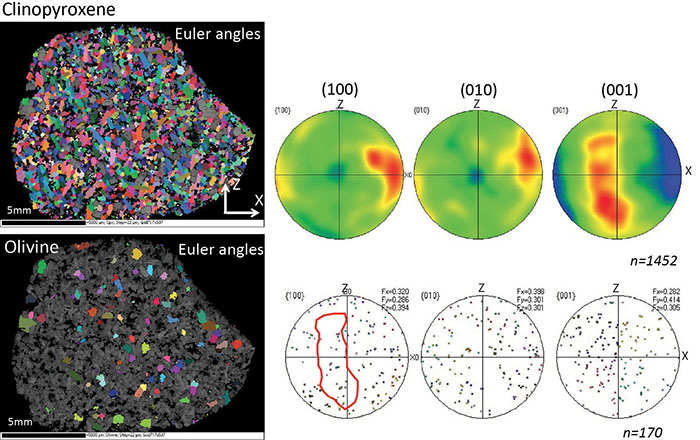 Both Nakhla and Zagami samples record primitive igneous processes, yet these have been partially overprinted by shock metamorphism. The combination of geochemistry and deformation provides a more detailed understanding of the texture and propose a relative timing of these events on Mars.
Both Nakhla and Zagami samples record primitive igneous processes, yet these have been partially overprinted by shock metamorphism. The combination of geochemistry and deformation provides a more detailed understanding of the texture and propose a relative timing of these events on Mars.
Carbonate phases present in Antarctic meteorite ALH84001 are Fe-Mg-Mn-Ca carbonates. New backscatter images document the carbonates that had been analysed with an ion microprobe in July 2012. These pictures are the basis for detailed chemical profiles of the carbonates with electron microprobe. We are preparing carbonate standards that need to be analysed with the electron microprobe.
Published outputs:
CCFS 2013 Publications #278, 301, 403, 404, 405, 406, 407, 408, 409, 412, 420, 426, 427, 428, 429, 430, 431, 432
Conference Presentations:
2 International conference presentations

8. DIAMOND GENESIS: CRACKING THE CODE FOR DEEP-EARTH PROCESSES
Theme 2, Earth Evolution, contributing to understanding Earth’s Fluid Fluxes.
AIMS:
This project combines LAM-ICPMS analysis of diamonds, developed at Macquarie, with other types of in situ data to define the nature and evolution of diamond-forming fluids. The causes of isotopic variability of carbon, oxygen, nitrogen and sulfur in diamond-forming fluids will be constrained; are these primary signatures, or do they reflect isotopic fractionation during diamond growth? We work towards understanding the links between diamond formation and the redox state of the lithospheric and asthenospheric mantle, and to developing new exploration and evaluation methodologies for application to kimberlites by defining the trace element signatures of mantle minerals that have been exposed to diamond-bearing fluids. Finally, different types of mantle fluids and their interactions with mantle rocks will be characterised.
PROGRESS DURING 2013:
Extensive work on mixed-habit diamonds demonstrated the sectorial partitioning of trace elements and in some cases C isotopes, during growth of these unusual diamonds. N isotopes were analysed in collaboration with R. Stern (Edmonton) and demonstrated that while there is little change in isotopic composition from core to rim, there is a small but significant fractionation between the different sectors. The trace-element analyses have applied the new high-precision, high-sensitivity analytical techniques developed through 2012, and have confirmed the difference in fluid compositions involved in the formation of gem diamonds versus fibrous diamonds. This work has led to a new model for diamond crystallisation, and a clearer definition of the position of mixed-habit diamonds in the scheme of diamond formation.
Related comparative studies on mantle xenoliths revealed further information on the sources and compositions of deep mantle fluids. Of particular note is the multi-isotope study on the isotopic characteristics of LIMA minerals from the Jagersfontein kimberlites, identifying a HIMU reservoir mantle source for the parental fluids.
Dr Howell travelled to Beijing in 2013 to select a representative sample of the diamonds extracted from peridotite massifs and their chromitites in Tibet and the Polar Urals. A detailed characterisation of this sample suite is in progress; this has required the development (in collaboration with colleagues in Physics) of new micro-milling techniques to obtain undisturbed cross sections through the centres of these tiny (100-200 micron) diamonds. 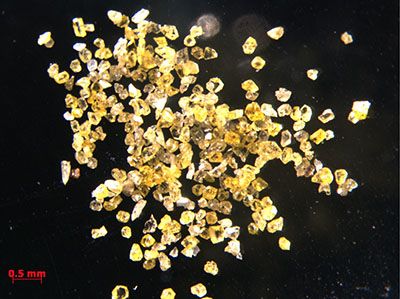
Micro-diamonds from Tibet.
PhD student Ekaterina Rubanova completed her thesis and graduated in 2013. Her thesis work has provided new insights into diamond crystallisation and its links to other metasomatic processes in the cratonic lithosphere. In particular, the presence of both diamondites (polycrystalline aggregates, from rapid crystallisation) and zoned monocrystalline diamonds in the same samples has allowed an assessment of the relative time-scales and changes in fluid composition involved in the growth of the two types of diamond.
Published outputs:
CCFS 2013 Publications #210, 328, 332, 211, 236, 320
Conference Presentations:
4 International conference presentations

9. 4D LITHOSPHERIC EVOLUTION AND CONTROLS ON MINERAL SYSTEM DISTRIBUTION: THE WESTERN SUPERIOR-YILGARN COMPARISON
Theme 2, Earth Evolution, contributing to understanding Earth’s Architecture.
AIMS:
This project is the first case study to obtain the full range of zircon multi-isotopic data and spatially map it over the Superior Province. Traditionally researchers have taken isotopic and whole-rock geochemical data and presented them as a few data points in chart form. In contrast, we undertake an order of magnitude more analyses in order to effectively map the data spatially.
The project aims specifically to (1) apply multi-isotopic (U-Pb, Lu-Hf, O) analyses in zircon to map deep lithospheric architecture in space and time, (2) determine if the distribution of mineral systems (VMS, Fe, NiS, Au) shows strong control by this architecture, as it appears to in the Eastern Goldfields Superterrane of the Yilgarn Craton, and (3) generate mappable criteria for targeting exploration for various Archean mineral systems at the craton to terrane scale.
PROGRESS DURING 2013:
A new PhD candidate Katarina Bjorkman started in February 2013 to study the Marmion Terrane in detail. Fieldwork in 2013 was focused on regional sampling, stratigraphic and structural study of greenstone belts, and localised study of mineralisation. A total of 222 samples were collected for whole-rock analyses and thin sections. Of these samples, 100 will be selected for zircon U-Pb, Lu-Hf, and O isotope analyses. Field investigations targeted areas poorly understood or with conflicting observations and/or interpretations in order to put the mapping and observations of previous workers in context and to interpret the tectonic history of the terrane. Structural observations, both at the regional and outcrop scale, support final NW-SE compression for the area, and stratigraphic observations support autochthonous development of the greenstone belts. This interpretation will be tested by a spatially constrained multi-isotopic study. In most instances, contacts between the greenstone belts and the underlying, marginally younger TTG are intruded by mafic dykes and young tonalite. Deformation is concentrated in the contact areas. Gold mineralisation occurs near NE-trending sinistral structures and contrasting lithology but within a variety of host rocks and with variably altered mineral assemblages. The 10.7 M oz Hammond Reef gold deposit is located within the 3.0 Ga Marmion Intrusive Complex along intersecting structures. These observations will be integrated with isotopic and geochemical analyses, will be used to constrain the crust-mantle evolution of the Marmion Terrane and related mineralisation. In 2013, 63 samples were dated by zircon SHRIMP method and 30 samples were analysed for LA-MC-ICPMS Lu-Hf isotopes. Zircon oxygen isotopic analysis was not available due to technical difficulties with the Cameca IMS 1280 in 2013. In addition, whole-rock major and trace element analysis was done for 112 samples.
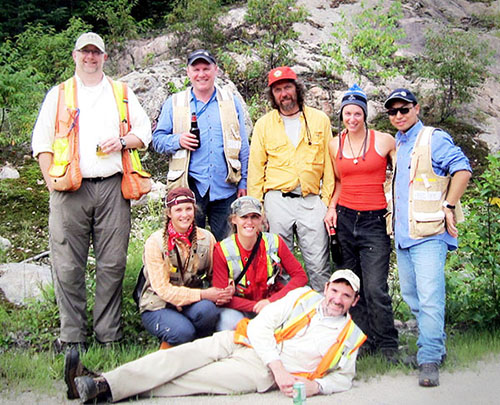 Field work in Wabigoon. Cam, Yongjun and Katarina are with colleagues from Lakehead Uni., OGS and Bjorkman prospector family.
Field work in Wabigoon. Cam, Yongjun and Katarina are with colleagues from Lakehead Uni., OGS and Bjorkman prospector family.
This project has attracted strong collaborations and leverages in 2013. The concept and methodology of this project has now been expanded to Tibet and the Uchi/North Caribou Terranes in Canada, in collaboration with the Chinese Academy of Geological Sciences (CAGS) and Lakehead University, respectively. The zircon multi-isotopic mapping in Tibet has led to an exciting discovery, showing that porphyry copper systems cluster exclusively within the juvenile domain and not in the ancient block, which could potentially become an effective regional targeting tool for the exploration industry. Moreover, these data are revealing the underlying structure of the Tibetan plateau and its evolution through time. A new NSFC project was also established together with CAGS to study the lithospheric architecture and mineral systems in the Eastern Tethyan belt, focusing in Tibet and Iran, which successfully attracted ¥3.3 million and will run from 2014 to 2018. A self-funded visiting professor Hooshang Asadi Haroni from Iran has joined CET for one year, forging a stronger collaboration in the study of Iranian mineral systems. Moreover, the Ontario Geological Survey in Canada has offered to conduct whole-rock geochemistry for over 200 samples at no cost to this project. Industry has also shown great interest in this project; we have been approached by companies such as De Beers Canada and Chalice Gold Mines to integrate our research with their practical exploration.
There have been about 200 samples collected from this study for the zircon multi-isotopic analysis, which is the largest and most complete such dataset in Superior Province collected to date. Results have shown that the lithospheric architecture wielded strong control on the location of gold mineralisation in the Wabigoon Subprovince. The concepts and methods of this project are now being actively applied in other parts of the world, which places CCFS as the world leader in applying multi-isotopic mapping globally.
Published outputs:
CCFS 2013 Publications #32, 162, 206, 222, 243, 350
Conference Presentations:
4 International conference presentations

10A. 3D ARCHITECTURE OF THE WESTERN YILGARN CRATON
Theme 2 and 3, Earth Evolution and Earth Today, contributing to understanding Earth’s Architecture.
AIMS:
This project aims to develop an integrated 4-dimensional, model of crustal evolution for the western Yilgarn Craton, and to derive a better understanding of the mineralisation processes for this region, how the crust links to underlying lithospheric mantle, and what relationships this piece of lithosphere has with the more highly endowed Eastern Goldfields Superterrane in the eastern part of the craton.
PROGRESS DURING 2013:
Significant steps have been taken to address crustal evolution of the western Yilgarn Craton, including the release of the deep seismic reflection and magnetotelluric surveys over the Youanmi, South Carnarvon, and Yilgarn Craton-Officer Basin-Musgrave Provinces, the holding of a CCFS project definition meeting, targeted field work in several locations in the Yilgarn, and the planning and partial deployment of passive seismic arrays. Three individual seismic lines (YU1, YU2 and YU3) and complementary magnetotelluric data were acquired across the northern Yilgarn Craton in 2010, with acquisition, processing and interpretation managed by Geoscience Australia. The lines are located in the northern part of the Yilgarn Craton from the Narryer Terrane in the northwest, crossing major bounding and internal structures of the Youanmi Terrane and proceeding into the Kalgoorlie Terrane of the Eastern Goldfields Superterrane. The northwestern end of YU1 is east of the southern end of line CP3 from the 2010 Capricorn seismic survey. The two surveys are linked by the Southern Carnarvon Basin seismic survey, acquired by Geoscience Australia in 2011. The eastern end of YU2 crosses major structures on the western side of the Eastern Goldfields Superterrane, augmenting the images from the 2001 Geoscience Australia seismic line about 120 km to the southeast. The Youanmi and Southern Carnarvon and the Yilgarn Craton – Officer Basin – Musgrave Province deep seismic reflection surveys add to the existing network of deep-crustal seismic surveys, and have closed a major data gap in the crustal structure of Western Australia, providing a traverse around 1800 km long across almost the entire southern half of Western Australia.
A major paper was released in 2013 on the tectonic development of the Murchison Domain of the Youanmi Terrane, Yilgarn Craton, providing a holistic framework for the history of the western Yilgarn craton and tying it in with development of the Eastern Goldfields Superterrane, highlighting overlaps in development that predate proposed terrane accretion. This summary presents a major compilation of map, structural, geochronological, and geochemical data that, when combined with isotopic and geochemical data provides a framework for future research of this heavily mineralised terrane.
Targeted field work has been carried out in the western Yilgarn, including mapping and sampling in the Murchison and Narryer terranes. Nd-isotope data suggest that the Youanmi Terrane has behaved as a coherent crustal block since at least 3000–2900 Ma ago. It is bounded by crustal-scale fault zones that dip away from the nucleus. The accretion of the Eastern Goldfields Superterrane, which may be either an exotic terrane or an extended margin of the Youanmi Terrane, marked the amalgamation of the composite Yilgarn Craton by about 2655 Ma ago. The Narryer Terrane is generally interpreted to have accreted onto the Youanmi Terrane in the northwest, but further work is required to better define the nature of the Narryer Terrane–Youanmi Terrane boundary.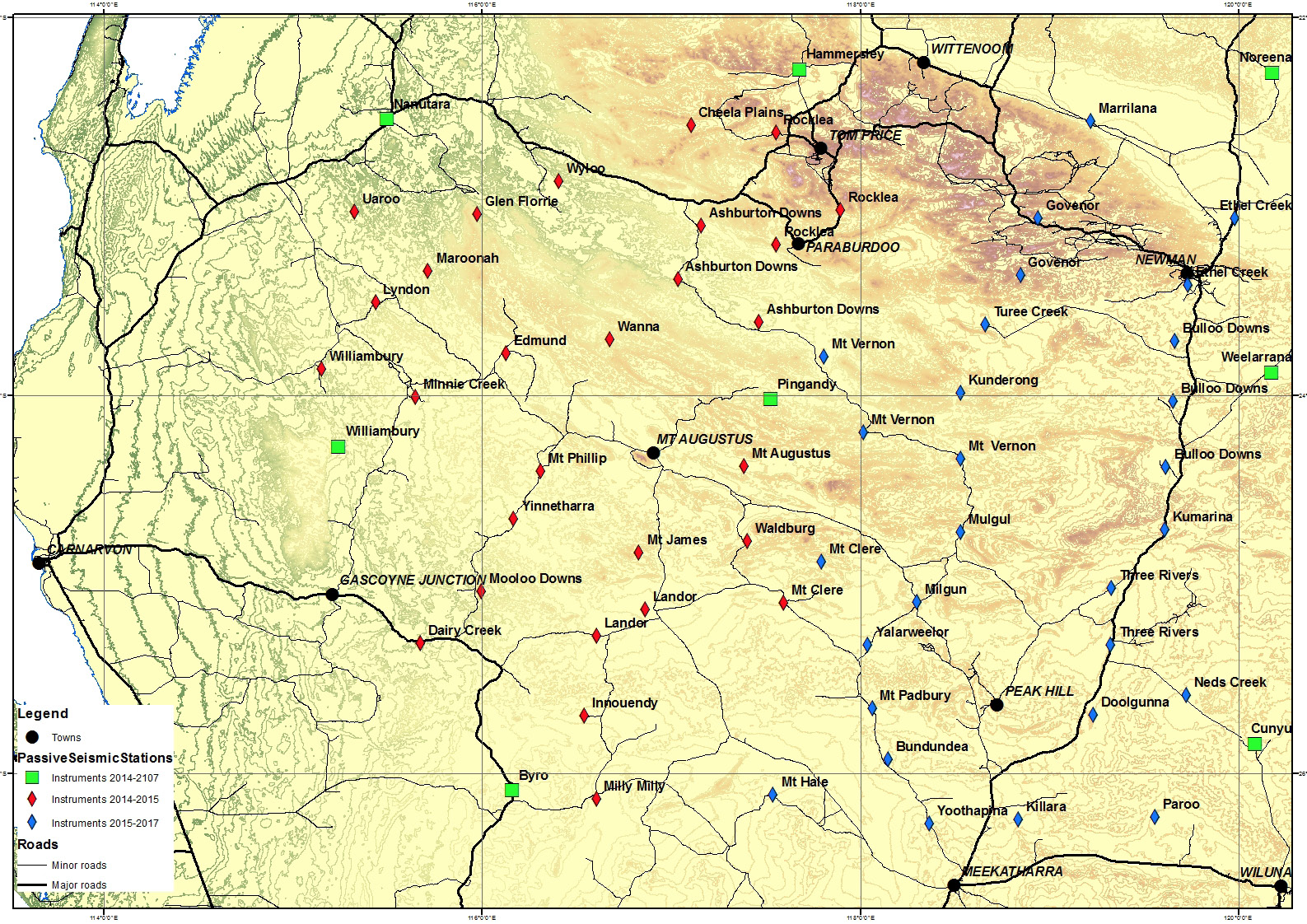
Capricorn seismic sites.
The Youanmi seismic reflection survey release workshop on 27 February 2013 was very successful and attracted a capacity crowd of more than 90 attendees at the WA Department of Mines and Petroleum Mineral House Auditorium. Attendees from the Resources Industry, Academia and Government provided very positive feedback and engaged in fruitful discussions.
The passive source (Earthquake) component of the project started in the second half of 2013 after Dr Huaiyu Yuan joined the program from UC Berkeley. Dr Yuan’s specialities are crustal and lithospheric structural imaging using earthquake imaging methods.
Careful planning of the Capricorn Orogen Passive Array (COPA) passive source study has been carried out during the second half of the year with seismic waveform dataset available already, and also with data that will become available in the coming years. A list of passive source methods have also been planned in conjunction with the deployment in March 2014. In parallel to the COPA development, in order to develop a technical template for revolving seismic anisotropy structure for long-operating stations, Dr Yuan and his US colleague targeted several permanent sites in the US, and observed promising anisotropic signals that may be related to fossil rifting processes and the current plate-asthenosphere coupling. The newly developed technique will be applied to the previously collected seismic waveform data and data from the semi-permanent sites in Western Australia in the coming year.
Published outputs:
CCFS 2013 Publications #248, 355

10B. ZIRCON LU–HF CONSTRAINTS ON PRECAMBRIAN CRUSTAL EVOLUTION IN WESTERN AUSTRALIA
Theme 2, Earth Evolution, contributing to understanding Earth’s Architecture.
AIMS:
The project aims to generate Lu–Hf isotope data, and integrate them with geological, geochemical, and geophysical information to understand the evolution of continental crust in Western Australia. Efforts will be directed at addressing specific geological questions in key areas, particularly along new geophysical transects, as well as in under-explored ‘greenfield’ regions, where the new information will improve the targeting of mineral exploration.
PROGRESS DURING 2013:
More than 1400 zircon analyses from 59 samples were selected for Lu–Hf analysis during 2013, so that over 200 samples (ca. 4000 zircons) have been analysed since the start of the project. The samples were drawn from the Pilbara Craton, Murchison Domain, Kimberley and Amadeus Basins, and the Gascoyne Province. Unfortunately, data collection was adversely affected in 2013 by instrument instability, although significant progress was made with interpretation of previous data. This project has made excellent progress in integrating zircon Lu–Hf isotope data with geological, geochemical, geophysical, and other isotope information to understand the evolution of continental crust in Western Australia.
Searching for a suture to the east of the Albany–Fraser Orogen
The Arid and Barren Basins are remnants of two major sedimentary basins within the Albany–Fraser Orogen. The Barren Basin comprises Paleoproterozoic metasedimentary rocks that overlie the Yilgarn Craton, Northern Foreland, the Biranup Zone (itself intruded by certain Biranup Zone magmas), and the Nornalup Zone. Barren Basin samples yield late Archean and Paleoproterozoic detrital zircons with a median εHf of +1 and a range of +6 to -18. Two-stage model ages reveal similarities with magmatic rocks of the Biranup Zone and Yilgarn Craton. The Arid Basin consists of metasedimentary rocks that have maximum depositional ages younger than the ca.1660 Ma Biranup Orogeny, but were intruded by Stage I magmas. Detrital zircons in the Arid Basin samples indicate latest Paleoproterozoic to mid-Mesoproterozoic age components, and yield a median εHf of 0 and a range from +12 to -17. Two-stage model ages show similarities with model ages in the Biranup Zone of the Yilgarn Craton, and include a new 2.0 Ga model-age component not seen in the Barren Basin. Importantly, the youngest detrital zircons, at 1455–1375 Ma, dominate the Arid Basin samples, but do not correspond to any known sources within the Albany–Fraser Orogen. They also have the most juvenile Lu–Hf isotope signatures of any detrital zircons in the orogen. The source of this material is thought to be juvenile rocks of probable oceanic affinity in the Madura Province. The exciting tectonic and geodynamic implications of these results are currently being assessed.
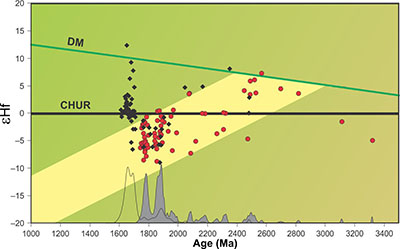
Figure 1. Age- Hf data for zircons from the Arunta region.
Links between the Warumpi and Aileron Provinces, west Arunta region
The Arunta Orogen comprises a large part of the southern margin of the North Australian Craton (NAC) and records episodic tectonothermal activity spanning almost 1.5 billion years from the Paleoproterozoic to the Devonian. The Warumpi Province forms the southernmost part of the Arunta Orogen and is separated from the older, 1860–1700 Ma Aileron Province to the north by the Central Australian Suture. The Warumpi Province has been considered exotic to the NAC. However, Hf-isotope evidence for mixing between 1690–1630 Ma mantle-derived melts and older sources indicates that the history of the Warumpi Province involved interaction with significantly older crust of at least Mesoarchean age (Fig. 1). The ages and Hf-isotope compositions of inherited zircons in the 1677 Ma Pollock Hills Formation are consistent with this older crust being part of the Aileron Province. This suggests that the Warumpi Province represents a slice of Aileron Province crust, rifted away from the southern margin of the NAC at, or prior to, 1690 Ma.
Published outputs:
CCFS 2013 Publications #209, 275, 324, 337, 362, GSWA Reports 120, 122, GSWA Record 2013/9
Conference Presentation:
1 international conference presentation
Foundation Centre Technology Development projects
(Whole-of-Centre projects)
1. CAMECA ION MICROPROBE DEVELOPMENT: MAXIMISING THE QUALITY AND EFFICIENCY OF CCFS ACTIVITIES WITHIN THE UWA ION PROBE FACILITY
AIMS:
The Centre for Microscopy, Characterisation and Analysis (CMCA) at UWA is home to two state-of-the-art Secondary Ion Mass Spectrometers: the CAMECA IMS 1280 large-radius ion microprobe, for the high-precision analysis of stable isotopes in minerals, and the CAMECA NanoSIMS 50 for imaging mass spectrometry at the sub-micron scale. In addition to the analytical capabilities located at the other nodes, the CCFS is poised to become a world-leader in in situ stable isotope analysis.
This project provides a dedicated Research Associate for the development of CCFS activities utilising the CAMECA Ion Microprobes at UWA, thereby increasing the capacity of the facility, enabling a higher degree of interaction and participation on projects, and allowing greater synergy with other CCFS node facilities. The Research Associate plays an integral role in experimental design, planning, sample preparation, and the acquisition, processing and interpretation of data. The complex nature of the ion microprobes demands a high-degree of technical ability, while an understanding of the aims of the individual projects requires a deep understanding of geological and geochemical processes. This is fundamental to the generation of high-quality in situ elemental and isotopic data for a diverse range of projects and, as such, represents a significant investment into the overall success of the CCFS.
PROGRESS DURING 2013:
Recent successes in ARC LIEF funding will update the electron microscopy facilities, with the addition of a FEI Titan TEM and a FEI Verios 460 SEM. The CMCA will also receive funding for a new Cameca NanoSIMS 50L ion probe through CSIRO’s Science and Industry Endowment Fund (SIEF). The new instrument will be part of the tripartite Advanced Resources Characterisation Facility, along with a Geo-Atom Probe to be located at Curtin University, and the in-house development of a MAIA mapping facility at CSIRO. The NanoSIMS 50L represents a considerable technological advance over the existing NanoSIMS, with a seven-FC/EM multicollector array and a new oxygen ion source allowing high-resolution isotope measurements on geological samples.
2013 saw a number of staff changes at the CMCA. Laure Martin and John Cliff continued to develop standards and analytical protocols for isotopic measurement using the Cameca IMS 1280
ion probe. Matt Kilburn spent six months on sabbatical at Harvard University, learning about the intricacies of applying NanoSIMS to biomedical research. David Wacey returned from overseas to work full time on Foundation Project 5. Paul Guagliardo replaced Rong Liu at the CMCA, and Malcolm Roberts replaced David Adams, who made an inter-node move to take up the position of EPMA operator at GEMOC (Macquarie).
The Ion Probe Facility at CMCA was highly productive during 2013, contributing to a number of projects across the whole CCFS. Highlights include:
[1] Metasomatism in the mantle (Jin-Xiang Huang, Yoann Gréau, Bill Griffin, Suzanne O’Reilly, Norman Pearson, John Cliff, Laure Martin). Garnets from a key Roberts Victor eclogite were analysed for oxygen-isotope compositions by SIMS (CAMECA IMS 1280) on grain mounts. The δ18O values of the garnet decrease from 8.2 to 5.7 ‰ as the MgO content increases from one side of the hand specimen to the other, providing important evidence for progressive metasomatism, further constraining the origin of xenolithic eclogites.
[2] Textural and spatial variability in multiple sulfur isotope biosignatures (David Wacey, John Cliff, Mark Barley). The CAMECA IMS 1280 has been used to analyse several sets of Precambrian sulfides in order to determine sulfur sources during the pyritisation of potential organisms in deep time. Here we have measured all 4 stable sulfur isotopes. Samples include pyritised Ediacaran (560 Ma) macrofossils, 1.9 Ga pyritised microfossils from the Gunflint chert, and possible pyritised microfossils in a 3.2 Ga black smoker type deposit. This high-spatial resolution in situ data provides unique insights into Precambrian biological cycling of sulfur. One paper has been published in PNAS in 2013 (Wacey et al. 2013) and a further 3 manuscripts containing IMS 1280 data are in review.
[3] Isotopic standards development (John Cliff, Laure Martin).
Due to the strong ‘matrix effect’ inherent in SIMS analysis, each new material requires a chemically (and isotopically) homogeneous standard of known composition with which to calibrate the instrument. In addition, the testing of new standards extends our capabilities into hitherto unexplored isotope systems. Recent development has included Si isotopes in silicates, SiC and Si metal, as well as Zr isotopes in zircon crystals from different provenance. Standards are in constant development at CMCA and currently include a range of Si-bearing materials (SiC, Si metal, silicates) for Si isotopes. Development continues on diamond (C isotopes), lawsonite, pyroxene, garnet and olivine (O isotopes), tourmaline and serpentine (B isotopes), pentlandite, pyrrhotite and chalcopyrite (S and Fe isotopes). The development of standards for unknown isotope systems aims to identify potentially new geochemical tools.
[4] Ultra-fine resolution diffusion studies (Matt Kilburn, Marco Fiorentini, Zoja Vukmanovic). The NanoSIMS proved once again that size does matter as a number of projects employed the ultra-high spatial resolution to determine diffusion profiles across mineral interfaces. One study, published in Chemical Geology (Saunders et al., 2014), demonstrated how our increased ability to measure diffusion profiles can be used to better constrain the timing of volcanic processes on the order of days to years. Similarly, high-resolution imaging with NanoSIMS combined with EBSD and LA-ICPMS imaging revealed the presence of trace elements along twin boundaries in pyrrhotite. These data (Vukmanovic et al., 2014) are interpreted as intragrain diffusion during syn- and post-deformation.
A number of CCFS projects featuring data from the Ion Probe Facility were published during 2013, including two papers in the prestigious Proceedings of the National Academy of Science.
Published outputs:
CCFS 2013 Publications #32, 162, 275, 321, 362, 426, 437, 438, 439.
Conference Presentations:
5 international conference presentation
2. FRONTIERS IN INTEGRATED LASER-SAMPLED TRACE-ELEMENT AND ISOTOPIC GEOANALYSIS
AIMS:
The project aims to enhance the world-class facility for in-situ isotopic and elemental analysis at GEMOC, in order to maintain Australia’s LAM-ICP-MS capabilities at international standards, and to advance beyond it in some aspects. The advances will be based on femtosecond-laser sampling and the coupling of instruments for simultaneous analysis.
PROGRESS DURING 2013:
The past year saw the installation of three new pieces of cutting-edge instrumentation:
[1] Femtosecond Laser Microprobe: A Photon Machines fs198 laser system was installed in June 2012. Due to recurring damage to optics, the beam delivery system was redesigned and replaced in January 2013 (and commissioned in July 2013).
[2] SF-ICP-MS: A Nu AttoM high resolution sector field (SF)-ICP-MS was installed in January 2013. The features of this instrument include the continuously variable high-resolution capabilities, fast electrostatic scanning/jumping and a fully laminated, high-scan-speed magnet. Activity on the Nu AttoM in 2013 has concentrated on the transfer of in-situ methodologies from the quadrupole ICP-MS with an emphasis on U-Pb geochronology of zircon.
[3] Excimer Laser systems: In addition to the femto-second laser, a Photon Machines Excite 193 nm excimer laser system was installed in June 2012 and was followed by a Photon Machines Analyte G2 193 nm excimer laser system in January 2013. The Excite has been used with the Agilent 7700 for all in-situ U-Pb and trace-element analytical work. The Photon Machines Analyte G2 excimer has enabled the first phase of an experimental program to investigate fundamental properties of nanosecond and femtosecond ablation processes in geological materials, focusing on laser-induced isotopic fractionation. The first phase has focused on the ablation characteristics of zircon and the fractionation of U-Pb.
Due to issues with the femto-second laser system and the delays in the delivery of the Nu AttoM, the planned development of the split-stream methods was put on hold. In its place a program was established to evaluate a range of new methods (proof-of-concept) and to refine and improve existing procedures.
Evaluation of standard reference materials (silicate) for combined measurement using laser ablation ICP-MS and MC-ICP-MS
The development of potential microbeam standards for combined laser ablation ICP-MS and MC-ICP-MS requires characterisation of the chemical (major and trace elements) and isotopic compositions. Studies undertaken include the following:
(i) the suitability of gem-quality zircon from the Mud Tank carbonatite as a reference standard for trace element and U-Pb and Lu-Hf isotopes. The results demonstrated the uniformity of U-Pb and Hf isotopes, but the trace-element compositions varied with the colour of the stone.
(ii) the on-going development of garnet standards for the in-situ measurement of Mg (laser ablation MC-ICPMS and SIMS) and O isotope composition (SIMS development in collaboration with UWA-CMCA)
(iii) the assessment of a variety of accessory minerals (baddeleyite, apatite, rutile) for U-Pb geochronology; this has lead to the development of new methods for U-Pb geochronology
(iv) the evaluation of osmiridium, Pt-rich alloys and laurite for in-situ Re-Os isotope analysis
(v) refinement of in-situ Sr and Nd isotope ratio measurement of perovskite and apatite
Incorporation of operating protocols for combined measurement using laser ablation ICP-MS and MC-ICP-MS into GLITTER data reduction software
GLITTER is software for ICPMS Laser-ablation data reduction developed at GEMOC, Macquarie University and commercialised through AccessMQ. Revision of GLITTER has commenced to expand its capabilities and functionality, with the primary goal of enabling the simultaneous treatment of combined trace-element and isotope ratio measurements. Additional emphasis has been placed on the identification and propagation of uncertainties for isotope ratio and the treatment of short duration transient signals (laser shot or ‘burst’ analyses).
New features in the GEMOC lab ‘beta-testing’ include automatic loading of new data; loading of internal standard data from a user-defined file; user defined plotting; entry of internal standard values as oxide or ppm; mouse control for the selection of the rise-time indicator; improved support for Agilent’s MassHunter output (automatic loading of dwell-time information). Features currently under development include multi-stage fitting to the standards; user-defined uncertainties on individual uncertainties for standard ratios; choice of calculation by ‘mean of ratios’ or ‘ratio of means’ in isotope ratio routines; support for output from Nu AttoM and Nu Plasma mass spectrometers; support for the output from Thermo Neptune and Qtegra.
Development of new sample preparation methods for geochemical and isotope analysis in the GAU
The advancement of geochemical methodologies and techniques in the Geochemical Analysis Unit at Macquarie University continues to be a significant factor in the establishment of new research initiatives and underpins many of the CCFS projects. The development projects listed below were undertaken in support of CCFS-funded research programs and to lay the foundations for future split-stream applications.
(i) New sample preparation methods for the separation and purification radiogenic isotopes (Rb-Sr and Sm-Nd radiogenic isotope systems and preliminary experiments have commenced for Lu-Hf) have involved the adaptation of conventional ‘macro’ techniques to micro sample volumes. This has been driven by the production of ‘contamination-free’ mineral separates using selFrag and the New Wave Micromill.
(ii) refinement of Li isotope methodologies for ultramafic rocks and adaptation to other applications (A-type granites, corals)
(iii) development of whole-rock trace element analysis of fused glasses by laser ablation ICPMS.
Published output:
CCFS 2013 Publications #306
Conference Presentations:
3 international conference presentations
3. OPTIMISING MINERAL PROCESSING PROCEDURES: FROM ROCK TO MICRO-GRAINS
AIMS:
Liberation and recovery of the accessory mineral components from any type of rock for geochemical and geochronological analysis. Many CCFS projects require the separation of accessory minerals from a range of different rock types. There are several major issues with these processes: breakage of grains, potential laboratory contamination, and the concentration and separation of extremely fine-grained phases. These problems can now be reduced if not eliminated by using new technology and newly developed procedures: (1) electrostatic pulse disaggregation (EPD); (2) the use of disposable sieves; (3) hydroseparation procedures for ultrafine material.
The first selFrag instrument in Australia was installed in GEMOC in May 2010. selFrag uses EPD to break rock samples into their component phases and produces better liberation of mineral phases, especially accessory minerals, than conventional crushing procedures. Because disaggregation proceeds along grain boundaries, it greatly increases the proportion of unbroken grains. Disaggregation takes place inside a large Teflon-lined container, which is easily cleaned to prevent cross-contamination.
PROGRESS DURING 2013:
selFrag is now routinely used for the defragmentation of a wide variety of different rock types and is the critical first stage in mineral separation procedures in GEMOC. The routine use of selFrag marks a significant achievement in method development and transfer of the established procedures to all users. In the past 3 years the defragmentation of each new rock type has required the development and refinement of experimental procedures depending on grain size, mineralogy and the amount of sample. One of the most important products of the intensive development phase of selFrag is a handbook of experimental conditions for a wide variety of rock types. This is a valuable resource for users with all levels of experience and has contributed to the efficient operation of the facility. The cumulative experience and expertise of the user group continues to grow and underlies the importance of the training program undertaken by all users as an important aspect of technology transfer. In 2013 selFrag was used to process 183 samples for 16 different research projects, including CCFS research projects (TARDIS; PhD projects; Honours), TerraneChron® and users from other institutions (ANU, CSIRO, University of Wollongong, NSW Geological Survey).
Since its installation the primary application of selFrag has been for the extraction of zircon grains for U-Pb geochronology and in 2013 this accounted for more than 90% of the samples processed. selFrag has increased the yield of zircon crystals and the liberated crystals are virtually unbroken and the surfaces are very clean. This has enabled the dating of rocks with low zircon abundances and expanded the application of the U-Pb technique to mantle geochronology (e.g. chromitites, peridotites). Other applications include the analysis of grain size and shape of phenocrysts and glass shards in volcanic rocks and the liberation of trace minerals from a range of mantle-derived and crustal rocks (e.g. alloys in mantle peridotites, platinum group minerals in chromitites), and archeological provenance studies using zircon ages from potshards. These applications highlight the advantages of selFrag over conventional comminution methods with the use of a small volume cell to extract mineral inclusions and the use of ‘sandwich-sieve’ to improve the yield of ultra-fine materials (see Research Highlight Tibet Chromitites).
Members of the 2013 CCFS Science Advisory Committee, Rob van der Voo and Giorgio Ronalli taking a guided tour of the selFrag lab with Bill Griffin.
selFrag is the centrepiece of the facility for mineral separation at GEMOC, but for most samples it is just the first stage in the separation process. The following further separation methods using material produced by selFrag have been developed and are being refined:
(i) sample sieving using disposable plastic/nylon sieves to prevent (cross-) contamination of samples
(ii) heavy liquid mineral separation using aqueous solutions of the nontoxic chemical sodium polytungstate (SPT) for heavy-mineral separation.
(iii) magnetic/paramagnetic separation using Frantz® Magnetic Barrier Laboratory Separator for separation of dry materials according to magnetic susceptibility, exploiting either paramagnetic or diamagnetic properties, resulting in three output fractions: magnetic, paramagnetic and non-magnetic.
(iv) micropanning equipment is available for further concentration of phases with densities slightly different from their matrix – best suited to grains >200 microns.
A hydroseparator (CNT-HS-11, manufactured by CNT Corporation, Canada) was purchased in 2011 and installed in 2012. This device processes samples of extremely fine-grained (down to a few microns) water-insoluble particles/grains to produce “heavy-mineral concentrates” from material of similar physical properties. The hydroseparator has been successfully used to process the ultra-fine material from selFrag to concentrate rare accessory phases such as alloys in mantle peridotites and platinum group minerals in chromitites.
ECSTAR projects
The following projects are supported by ARC Post-Award funds allocated mid 2011 for early-career researchers. These are ARC ECSTAR Fellowships (Early Career Startup Awards for Research). The two appointees in 2011 were Dr José María González-Jiménez, Xuan-Ce Wang, Takako Satsukawa was appointed in 2012 and Yongjun Lu in 2013.

ECSTAR PROJECT 1. PLATINUM-GROUP MINERALS: MONITORS OF DEEP EARTH PROCESSES
José María González-Jiménez: Supported by ARC CCFS ECSTAR (commenced 2011)
Themes 2 and 3, Earth Evolution and Earth Today, contributing to understanding Earth’s Architecture and Fluid Fluxes.
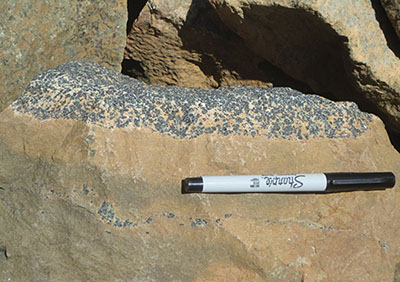
Nodular chromitites in dunite.
This project interfaces with Foundation Project 1, The TARDIS-E Project: “Tracking Ancient Residual Domains In the Silicate-Earth”. The Re-Os isotopic system in Platinum-Group Minerals (PGM) from Earth’s mantle potentially provides the most robust record of long-term interactions between distinct regions of Earth’s interior. However, the reliability of this approach needs further testing, because the chemistry of many PGM hosted in mantle-derived rocks has been modified by hydrothermal alteration or metamorphism during or before excavation of the mantle rocks from deep Earth to surface. The fact that PGM of different suites of mantle rocks exhibit variable scales of heterogeneity in Os isotopes suggests that post-magmatic alteration could also disturb the Re-Os compositions of these minerals. This project uses a combination of classical mineralogical methods and novel micro-analytical techniques for isotopic measurements to test the robustness of the Re-Os system in PGM from mantle-derived rocks affected by variable degrees of hydrothermal alteration and metamorphism, and thus to constrain the interpretation and applications of Os-isotope data.
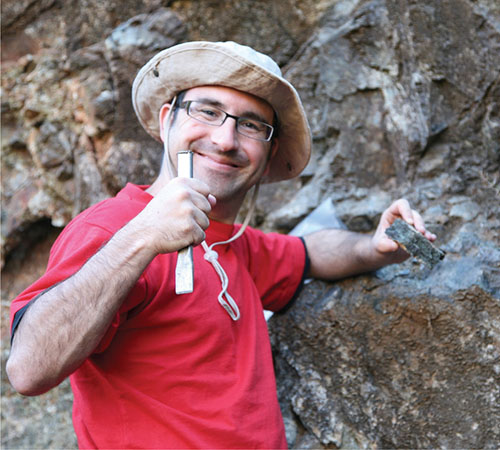
PROGRESS DURING 2013:
The strategic plan for 2013 has been fully accomplished, and the analysis of the samples collected by Dr González-Jiménez during 2012 from the ophiolites of the Coolac Serpentinite Belt in southern Australia, the Vizcaino Peninsula in northern Mexico and Dobromirtsi in southern Bulgaria have been completed. The results obtained from the study of the Dobromirtsi chromitites have been published in a paper submitted to a special volume of Gondwana Research on “Ophiolitic Peridotites, Ultrahigh Pressure Minerals and Podiform Chromitites: Their Origin and Evolution" (CCFS publication #348). In April, Dr González-Jiménez was invited by colleagues from the Dokuz Eylul University in Turkey to carry out fieldwork on the ophiolites of the Lycian Nappes. During this fieldwork Dr González-Jiménez and his colleagues recognised new styles of chromitite mineralisation in the ophiolitic mantle, and collected new samples of PGM-bearing chromitites. The identification of new styles of chromitite mineralisation led to the development of a new model for the formation of chromitites in ophiolites. The results of this research were published in two invited review papers hosted in a special volume of Lithos entitled “Lithosphere and Beyond” (CCFS publications #334 and #349).
During September-December Professor Mehmet Akbulut (Dokuz Eylul University, Turkey) and PhD candidate Vanessa Colás (University of Zaragoza, Spain) visited CCFS. Prof. Akbulut carried out in-situ Re-Os analyses on PGMs from chromitites of the ophiolites of the Lycian nappes. Visiting PhD, Vanessa Colás, carried out in-situ analyses of minor and trace-elements in chromitites from a suite of metamorphosed ophiolites, including Tehuitzingo (Mexico), Los Congos (Argentina) and Coolac Belt (Australia). The results obtained in her work show that alteration of chromite can only be produced during the infiltration of hydrothermal fluids at temperatures between 500-700˚C.

ECSTAR PROJECT 2. ESTABLISHING THE LINKS BETWEEN PLATE TECTONICS AND MANTLE PLUME DYNAMICS: MESSAGE FROM THE LATE CENOZOIC LEIQIONG BASALTS IN SE ASIA
Xuan-Ce Wang: Supported by ARC CCFS ECSTAR funding and NSFC (National Science Foundation of China) Project grant (commenced 2011)
Theme 2, Earth Evolution, contributing to understanding Earth’s Architecture and Fluid Fluxes.
Whether mantle plumes and plate subduction are genetically linked is a fundamental question that impinges on our understanding of how Earth works. Late Cenozoic basalts in southeastern Asia are globally unique in relation to this question because they occur above a seismically-detected thermal plume adjacent to major deeply-subducted slabs that also have been imaged seismically. The main goal of this project is to examine the petrogenesis of late Cenozoic continental flood basalts (CFBs) that are located directly above the plume-like mantle seismic structure, and spatially close to major subduction zones in southeastern Asia. We will take a multidisciplinary approach, determining the chemical composition of the primary melts of the basalts, characterising the chemical compositions of their mantle source, and examining the temporal-spatial variations in the geochemical characteristics of the Leiqiong CFB. We will also test the geological and thermochronological evidence for lithosphere uplift. The results will be used to test major predictions of plume models as well as other end-member geodynamic models for such unique CFBs. This study will advance our understanding of (1) the thermochemical state of the deep Earth where a lower-mantle-rooted plume-like seismic structure exists unusually close to subducted slabs; (2) relationships between geophysical and geological manifestations of mantle plume activities at mantle downwellings; (3) the nature and origin of enriched mantle source regions; and (4) the behaviour of mantle plumes at plate boundaries and inter-relationships between mantle plume dynamics and plate tectonic processes. Knowledge obtained in this project will help to address one of the most fundamental questions in geodynamics: how the two major processes of whole-mantle convection, i.e. deep subduction that drives mantle downwelling, and mantle plumes that drive mantle upwelling, relate to and interact with each other.
PROGRESS DURING 2013:
The most significant contribution of this project during 2013 was to provide a potential breakthrough hypothesis that links the generation, preservation, and sampling of early reservoirs into a self-consistent Earth system. In this year, we discovered that an ancient mantle reservoir formed at 4.5-4.4 Ga had been tapped by the ca 60 Ma old Baffin Bay high-magnesium lavas (CCFS publication #354) and late Cenozoic basalts from the Hainan-Leizhou peninsula, the Indochina peninsula and South China Sea seamount (CCFS publication #336). An in-depth analysis demonstrated that this ancient mantle reservoir is chemically heterogeneous, containing at least two (depleted and enriched) end-member components (CCFS publication #354). This implies that chemical effects of early differentiation can persist in mantle reservoirs to the present day, and challenges an enduring tenet of modern chemical geodynamics, that the Earth started as a well-mixed or homogeneous body which evolved progressively over the geological time into several chemically distinct domains. Consequently, the observable chemical heterogeneity in mantle-derived rocks cannot be simply linked directly to the chemical and physical structure and evolution of the solid Earth over the past 4.5 Ga. We proposed a new hypothesis that illustrated how global differentiation of the early silicate Earth from 4.55-4.40 Ga may have produced depleted and enriched dense melts in an undegassed deep Earth (CCFS publication #354). Such an early Earth differentiation would have occurred in two independent layers at >1,800 km and ≤1,800 km depths. The crystallisation of a transient magma ocean would produce an enriched denser liquid phase at >1,800 km depth. The denser melts may be further modified by metal-silicate segregation to produce coupled high Hf/W, Re/Os, and Pt/Os ratios at the base of a primordial magma ocean or in a partially molten zone at or near the core-mantle boundary. In contrast, within the upper layer (≤1,800 km), as the crystallisation proceeded, the residual liquid would rise buoyantly until a small fraction (≤1%) of melt ultimately formed a protocrust at the Earth surface, depleting 60% of the silicate Earth. The depleted dense melt may have been generated by high-degree partial melting of peridotite at about 300-410 km depths, shortly after magma ocean crystallisation. These two types of dense melts would result in materials constituting the present-day thermo-chemical piles hosted within the two large low-shear-wave-velocity provinces above the core-mantle boundary, that have been protected from complete entrainment by subsequent mantle convection currents. We argue that although such dense melts may exhibit some ‘primordial’ geochemical signatures, they are not representative of the bulk silicate Earth.
How such a dense chemical layer can be sampled and brought to the surface is another important question. Geological evidence related to supercontinent-superplume cycling shows that the location and formation of superplumes were dominantly controlled by the first-order geometry of global subduction zones. Recent studies have proposed that sinking subducted slabs not only can push the dense chemical layer upward, but at the same time push the thermal boundary layer to form thermal-chemical domes, enhancing or triggering thermal instability (CCFS publication #336). Our studies show that the late-Cenozoic less-contaminated and synchronous basaltic samples from the Hainan-Leizhou peninsula, the Indochina peninsula and South China Sea seamount occur above a seismically detected thermal plume adjacent to deep subducted slabs (CCFS publication #336). Thus, we proposed that young avalanched slabs may push up such a thermal-chemical pile to form a thermal plume. Such an ancient denser chemical layer therefore would continue to be sampled by mantle plumes (CCFS publications #336 and 354).
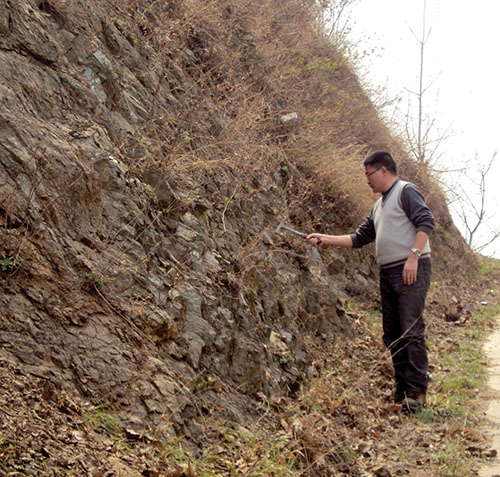
Xuan-Ce Wang in the field.
Published outputs:
2013 CCFS publications #19, 297, 336, 338, 343, 347, 354, 369, 371
AIMS AND WORK PLAN FOR 2014:
In 2014, the core task will be to conduct extensive analyses of Re-Os, Sm-Nd isotope and PGE abundance data obtained in 2013 from the mantle xenoliths hosted by the Hainan alkalic basalts, to constrain the evolution of the sub-continental lithospheric mantle and compare it with those of Cathaysia Block and Yangtze Craton. The specific aims in 2014 are:
(1) To conduct comprehensive in-situ olivine-oxygen and electronic microprobe analyses to examine the proportion of recycled components;
(2) To conduct whole rock major-trace element analysis on high-magnesium synchronous basalts of southeast China collected in 2013, to test whether or not they derived from high-temperature primary melts;
(3) To conduct analyses of short-lived 146Sm-142Nd isotopes to further test the relative roles of early Earth processes versus subsequent dynamic processes in shaping the Earth’s chemical architecture.
(4) To finish the manuscripts focusing on mantle xenoliths and submit in the middle of 2014;
(5) To prepare a paper focusing on the drill-core samples from the Hainan CFBs.

ECSTAR PROJECT 3. MAPPING THE DEFORMATION OF SUBCONTINENTAL LITHOSPHERE: THE EVOLUTION OF MICROSTRUCTURE AND FLUID-MELT-ROCK INTERACTION IN THE UPPERMOST MANTLE
Takako Satsukawa: Supported by ARC CCFS ECSTAR funding (commenced 2012)
Themes 2 and 3, Earth Evolution and Earth Today, contributing to understanding Earth’s Architecture and Fluid Fluxes.
This project interfaces with Foundation Project 1, The TARDIS-E Project: “Tracking Ancient Residual Domains In the Silicate-Earth”.
The deep Earth water cycle is strongly coupled to plate tectonics, and the evolution of the uppermost mantle is commonly controlled by partial melting and/or refertilisation processes. The amount of water carried into the deep mantle by descending oceanic crust is relatively small, but even trace amounts of water affect physical and chemical properties such as melting temperature, rheology, deformation mechanism, electrical conductivity, etc.
Cratons are domains of thick lithosphere with cold geotherms, which have remained stable for long geologic periods since their formation. The processes that result in the stability or destruction of the cratonic mantle roots are poorly understood, and are a major open question in geodynamics. In this project, we mainly focus on the rheology of the uppermost mantle and the history of the roots of ancient continents to provide new constraints on the rheological properties of the lithospheric mantle. The development of a systematic approach combining microstructural analysis, the mapping of Crystallographic Preferred Orientations (CPO), water contents, numerical modelling of the seismic properties of individual samples, and geochemical analyses of xenoliths from different lithospheric levels and different degrees of melt-rock interaction. Previous work by GEMOC has focused on geochemical analysis; we will develop a new methodology for mapping ‘hidden’ microstructures by combining these approaches. This approach will provide new tools for the investigation of rock deformation, the rheological state of the mantle and the styles of mantle dynamics. As this project has just started, we are now characterising the microstructural evolution of mantle-derived rocks from the cratonic lithosphere by exploring the CPO mapping of a statistically representative sample set, which previously was well characterised geochemically.
PROGRESS DURING 2013:
The Japan Sea is one of the back-arc basins distributed around the western rim of the Pacific. Its floor is composed of oceanic crust, rifted continental crust and stretched continental crust. However, the evolution of the back-arc spreading is not fully understood; for example, the cause of formation, processes of evolution, similarity and differences to the mid ocean ridge are yet to be fully described. Moreover, evolution of ocean basins is a fundamental component and they are particularly important for producing crust, deformation of the lithosphere, asthenospheric flow, partial melting, and melt/fluid rock interaction. To constrain these interactions, we studied the microstructural development in the uppermost mantle associated with melt-rock interactions in peridotite xenoliths from Shingu (SW Japan) and Seifu seamount (Japan Sea).
The Shingu peridotite xenoliths are hosted by a lamprophyre dike on Shikoku Island, Japan, which has a K-Ar age of 17.7 ± 0.5 Ma (Uto et al., 1987), before the formation of the Japan Sea. Thus, these peridotites may preserve features of the uppermost mantle prior to the back-arc spreading, whereas peridotite xenoliths in alkali basalt dredged from Seifu seamount, which has a K-Ar age of 8.09 ± 0.31 (Ishii personal comm.), represent direct samples of Japan Sea oceanic mantle.
The peridotite xenoliths have equigranular to porphyroclastic texture, with grain boundaries that range from triple junctions to smoothly curving boundaries. Some olivine grains are cut by pyroxenes. The mineral chemistry of the Shingu peridotites reveal a sequence of metasomatic events; 0) partial melting, 1) Fe-enrichment, 2) refertilisation with Ti and Al enrichment, 3) Al and REE (Rare Earth Element) enrichment. The Seifu peridotites can be classified into two types in terms of REE patterns of clinopyroxene; one shows slight enrichment in LREE and the other has high-REE cpx with flat to slightly LREE-enriched patterns.
The olivine CPO of Shingu peridotite is dominantly (010)[100] and subordinate {0kl}[100]. The sample, which was only influenced by the first metasomatism (Fe-enrichment), shows a (010)[100] slip system in olivine and (100)[001] in orthopyroxene. Other samples show no significant relationships among the minerals. This indicates that deformation was completed by the early stage of metasomatism. In contrast, the olivine CPO of Seifu peridotites is consistent with slip on (010)[100] and {0kl}[100]. In most samples, orthopyroxene crystals have irregular grain boundaries and are interstitial to the olivine grains. In spite of their grain shape, the slip system of orthopyroxene is consistent with that of the neighbouring olivine crystals, indicating that deformation of olivine and orthopyroxene occurred at the same time.
Combined with petrological and microstructural observations, we argue that the suite of the peridotite xenoliths records a rare snapshot of the uppermost mantle flow related to the initial stage of back-arc spreading. Geochemical characteristics reveal that fundamental melt percolation occurred both before and during back-arc spreading, suggesting that asthenospheric flow and deformation occurred in the presence of small melt fractions.
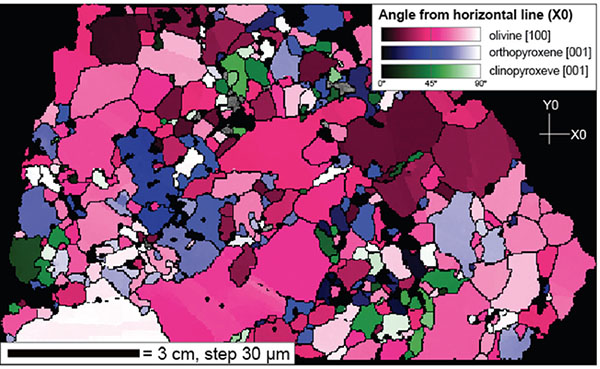
EBSD map of a peridotite xenolith from Seifu seamount (SW Japan).
AIMS AND WORK PLAN FOR 2014:
1. To develop a robust model for the deformation history of the roots of ancient continents (subcontinental lithospheric mantle) by using the constraints derived from microstructural characteristics. These sample sets are from the North China Craton (NCC) and the Kaapvaal Craton, and are well- characterised geochemically and petrologically.
2. To calculate CPO-derived seismic properties which will provide a unique basis for comparison with the detailed seismological data available in these areas.
3. To reveal the deformation history of chromitites in peridotite massifs. Chromite is nicely preserved indicating it was more resistant to fluid-related processes than the silicates of the peridotitic host rocks; this distinctive property makes chromitites very useful to track the evolution of Earth’s mantle convection.

 ARC Centre of Excellence for Core to Crust Fluid Systems
ARC Centre of Excellence for Core to Crust Fluid Systems